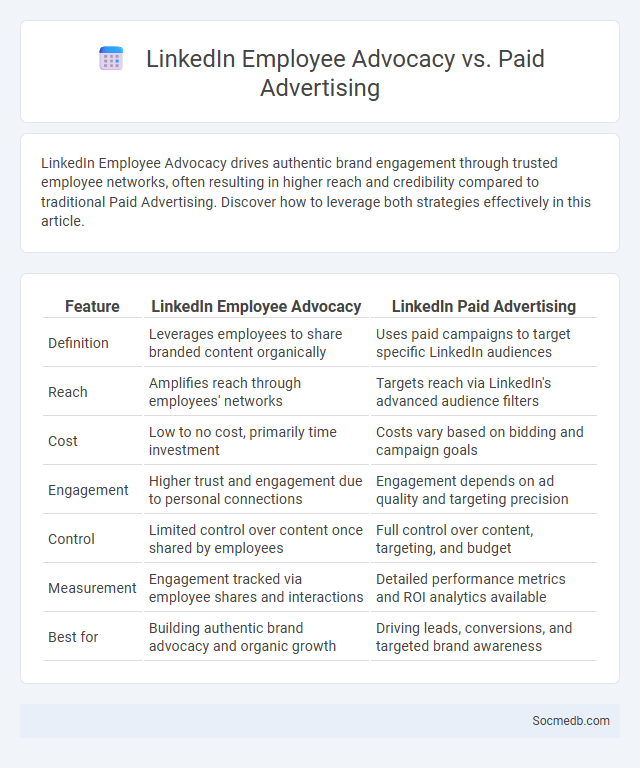
Photo illustration: LinkedIn Employee Advocacy vs Paid Advertising
LinkedIn Employee Advocacy drives authentic brand engagement through trusted employee networks, often resulting in higher reach and credibility compared to traditional Paid Advertising. Discover how to leverage both strategies effectively in this article.
Table of Comparison
| Feature | LinkedIn Employee Advocacy | LinkedIn Paid Advertising |
|---|---|---|
| Definition | Leverages employees to share branded content organically | Uses paid campaigns to target specific LinkedIn audiences |
| Reach | Amplifies reach through employees' networks | Targets reach via LinkedIn's advanced audience filters |
| Cost | Low to no cost, primarily time investment | Costs vary based on bidding and campaign goals |
| Engagement | Higher trust and engagement due to personal connections | Engagement depends on ad quality and targeting precision |
| Control | Limited control over content once shared by employees | Full control over content, targeting, and budget |
| Measurement | Engagement tracked via employee shares and interactions | Detailed performance metrics and ROI analytics available |
| Best for | Building authentic brand advocacy and organic growth | Driving leads, conversions, and targeted brand awareness |
Understanding LinkedIn Employee Advocacy
LinkedIn employee advocacy leverages employees' professional networks to amplify company content and enhance brand credibility. Engaging employees to share authentic updates increases organic reach and drives higher engagement compared to traditional corporate posts. Metrics such as share rate, engagement, and lead generation effectively measure the impact of LinkedIn employee advocacy programs.
What Is Paid Advertising on LinkedIn?
Paid advertising on LinkedIn involves promoting your content or brand through sponsored posts, text ads, or dynamic ads targeted to specific professional audiences. This platform's advanced targeting options allow you to reach decision-makers based on job title, industry, company size, and skills, optimizing your campaign's relevance and effectiveness. Using LinkedIn's paid advertising can significantly boost your visibility, helping you generate high-quality leads and enhance your professional network.
Defining Employee Advocacy Beyond LinkedIn
Employee advocacy extends beyond LinkedIn by leveraging diverse social media platforms such as Twitter, Instagram, and Facebook to amplify brand messaging and foster authentic engagement. Empowering employees to share company values and insights through multimedia content enhances reach and builds trust across varied audiences. Integrating employee advocacy with social listening and data analytics optimizes campaign effectiveness and drives measurable business outcomes.
Key Differences: LinkedIn Employee Advocacy vs Paid Advertising
LinkedIn Employee Advocacy leverages your employees' personal networks to share authentic content, enhancing trust and organic reach, whereas Paid Advertising targets specific audiences through sponsored posts and ads for precise campaign control. Employee Advocacy typically generates higher engagement and brand loyalty due to its personalized nature, while Paid Advertising offers scalable results and measurable ROI through detailed analytics. Understanding these key differences allows you to effectively balance genuine brand storytelling with strategic audience targeting on LinkedIn.
Benefits of LinkedIn Employee Advocacy Programs
LinkedIn employee advocacy programs amplify your brand's reach by leveraging authentic voices within your workforce, boosting credibility and trust among professional networks. These programs increase engagement rates and foster stronger connections with potential clients, partners, and industry influencers. Empowering your employees to share company content enhances recruitment efforts by showcasing a positive workplace culture and attracting top talent.
The Impact of Paid Advertising on LinkedIn Reach
Paid advertising on LinkedIn significantly amplifies organic reach by targeting specific professional demographics based on job title, industry, and company size. Sponsored content and InMail campaigns enhance visibility, engagement rates, and lead generation by delivering personalized messages directly to decision-makers. Data shows that businesses using LinkedIn ads experience up to a 35% increase in click-through rates compared to organic posts alone.
Authenticity and Trust: Employee Advocacy Advantages
Employee advocacy on social media enhances authenticity by showcasing genuine voices that resonate with audiences, fostering deeper trust in the brand. Authentic content created by employees often leads to higher engagement rates, as followers perceive it as more credible compared to traditional marketing messages. Leveraging employee networks expands brand reach while reinforcing transparency and reliability, crucial factors in building long-term customer loyalty.
Cost-Effectiveness: Advocacy vs Paid Campaigns
Advocacy marketing leverages genuine user endorsements and organic content, significantly reducing costs compared to paid social media campaigns that require substantial budget allocation for ads and targeting. Brands engaging in advocacy benefit from higher trust and engagement rates, often yielding improved ROI without continuous financial investment. Paid campaigns provide scalability and precise audience reach but can incur escalating expenses with diminishing returns if not optimized properly.
Measuring Success: KPIs for Each Approach
Measuring success on social media requires tracking specific Key Performance Indicators (KPIs) tailored to each platform's unique objectives. For brand awareness, KPIs include reach, impressions, and follower growth, while engagement rates, such as likes, shares, and comments, gauge content relevance and audience interaction. Conversion-focused campaigns prioritize click-through rates (CTR), cost per acquisition (CPA), and return on ad spend (ROAS) to assess the effectiveness of driving sales or leads.
Choosing the Best Strategy for Your Brand
Selecting the best social media strategy for your brand requires a thorough understanding of your target audience's demographics, behaviors, and preferences across platforms like Instagram, Facebook, and LinkedIn. Analyzing competitors' successful campaigns and leveraging data analytics tools can help refine content types, posting frequency, and engagement tactics tailored to your brand's unique voice. Ensure your strategy aligns with your business goals by setting measurable objectives that track growth in followers, reach, and conversion rates.
 socmedb.com
socmedb.com